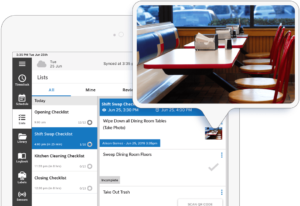Restaurant opening and closing checklists are key to setting your staff up for success.
Nearly every restaurant has them, but most still struggle to achieve true employee accountability for these critical duties, like cleaning, stocking, and setting up for the next shift’s success.
According to businesswire, 75% of consumers will not visit a restaurant with negative reviews about its cleanliness, so how do we improve completion rates on our two most important checklists?
To improve execution with opening and closing checklists in your restaurant, you have to create a culture of accountability in all your stores.
Below we outline exactly how to achieve accountability by moving from paper to digital checklists that measure—and improve—employee execution at opening and closing.
1. Quit Using Paper
Dirty restaurants don’t happen overnight.
In most cases, accountability for cleaning and setup duties slips further and further down the priority list until it’s completely ignored.
Instead of cleaning the bathrooms and setting up the drink station, employees are simply marking that it’s done and calling it a day.
There’s no accountability for these tasks, so they’re being falsified on a regular basis.
This is the great weakness of paper checklists.
Sure, paper provides a record, but the accuracy of that record is questionable, and management can’t rely on it to make informed decisions.
If you’re not measuring these checklists, they’re not improving.
Without micromanaging, there’s really no way to correct this, and making all your managers the “bad guy” isn’t the best way to get alignment on your team.
If you really want to stop pencil whipping, take away the pencil.
Move your opening and closing checklists from paper to digital.
2. Switch to Digital Cleaning Checklists
When employees can handwrite checklist items, they have the luxury of putting… well, anything they want.
They can claim a particular checklist item was done at any time, and can take credit for whatever completed duties they please.
Digital checklists help curb checklist falsification, and help you measure checklist completion percentages, day by day.
Digital checklists automatically name and time stamp every task the second it’s completed.
That means no employee can claim work for another employee, nor say a task was completed any other time than what it says on your digital checklist.
Even more, digital checklists go beyond the checkmark to give you photo-proof of completed work.
Want to make sure employees are turning the chairs and mopping every night at closing? Just require a photo of that task in your closing checklists.
The employee will then take photos each night, and it’s highly unlikely they’ll leave the floor dirty if they’re taking a photo of their work.
When you equip employees with tools that remove human error, you get results you can rely on.
An example of photo-proof inside a Jolt digital checklist.

In the case your employees do leave the floors dirty, you’ll know exactly who was responsible, and won’t be forced to hold a team meeting to address dirty floors.
Digital checklists give managers the visibility they need to run their stores effectively.
Your high-performing employees will appreciate getting credit for their hard work, and the low-performers won’t be able to hide behind falsified paper checklists.
Digital checklists will reintroduce accountability to your team, and help employees develop the right habits around keeping the store clean at opening and closing.
Execute this repeatedly, and you’ll see a visible difference in a matter of days.
3. Get Consistent with Opening and Closing Checklists
Now equipped with the right tools, your team should work towards consistently completing every item on your opening and closing checklists.
Using Jolt digital checklists, you’ll be able to set audible reminders for your team to complete tasks at specific times.
This will help foster a culture of accountability in your store, as employees will recognize store cleanliness and preparation as a priority.
Without the managers saying a word, your entire back of house team will be reminded it’s time to wash dishes, stock inventory, or wipe down the grill.
This gets your team in a rhythm of doing things the right way. And as you get more consistent, you can even add new tasks to the daily rotation.
The cleaner and more consistent your restaurant, the more customers will return (and bring their friends) for a quality meal.
Improve execution around your opening and closing checklists, and you’ll see that benefit reveal itself in annual revenue.
Jolt Digital Checklists Improve Cleanliness and Consistency
Digital checklists are the great advantage in back of house restaurant operations.
Not only do they make opening and closing checklists easier to complete, but Jolt gives you perfectly accurate records for any inspections that come your way.
But most importantly, you’re execution critical cleaning tasks each and every day, and that’s the kind of consistency it takes to build a business.
Interested in Jolt for your store? Request a demo here, and we’ll show you how digital restaurant operations can help improve your stores today.
